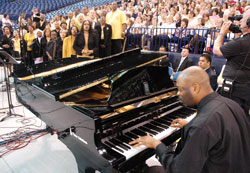Sung parts of new Mass translation can be used in archdiocesan parishes beginning in September

While playing a piano, Vincent Howard leads a choir from Holy Angels Parish in Indianapolis during the May 3, 2009, Mass at Lucas Oil Stadium in Indianapolis celebrating the 175th anniversary of the Archdiocese of Indianapolis. The U.S. bishops recently decided to give each diocese the option of using musical settings of some parts of the new Roman Missal translation beginning in September. (File photo by Sean Gallagher)
By Sean Gallagher
For approximately a year, parish leaders have known that the new translation of the Mass will be implemented starting on the weekend of Nov. 26-27, the first Sunday of Advent.
But when the U.S. bishops met in June, they decided to give each diocese the option of using musical settings of some parts of the new translation beginning in September.
The Archdiocese of Indianapolis has taken this option, and is allowing parishes to begin using new settings of the “Glory to God” and the eucharistic prayer acclamations. (Related: Workshops scheduled to help pastoral musicians with new Mass translation)
Charles Gardner, executive director of the archdiocese’s Secretariat for Spiritual Life and Worship, said this allowance does not apply to a prominent change in the new translation, “The Lord be with you. And with your spirit.”
He said the primary reason for taking the option for early use of some parts of the new translation of the Mass has to do with the “Glory to God.”
“It changes so much that, for the most part, completely new settings are going to be needed,” Gardner said. “And because the Gloria is not sung in Advent, the early use will enable a new setting to be in place for the Christmas season.”
For new Mass settings, Gardner said the Archdiocesan Liturgical Music Commission is recommending that parishes use either the chant setting of the Mass that will be in the new Roman Missal and in all missalettes, hymnals and worship aids or the Storrington Mass by Marty Haugen, available through GIA Publications Inc.
He said the chant setting is “the only universal musical setting” of the new Mass translation, and the Storrington Mass was recommended because of “its quality and its usability.”
“It is one that is quite adaptable for different instruments,” he said.
Staff members of the Office of Worship held workshops through the spring and early summer for pastoral musicians across the archdiocese to help them prepare for the implementation of the new Mass translation. Gardner said additional workshops will be held at parishes in September.
Whether parishes choose to use new musical settings of the “Glory to God” and the eucharistic prayer acclamations in September or wait until Advent, Gardner said that the role of pastoral musicians will be important.
“All of these musical changes do put an emphasis on the ministry of cantors and choirs as being enabling and helping by call and response,” Gardner said. “That’s the case, of course, when you’re learning anything new. But I think here, we’re going to need to make good use of those leadership techniques.”
(For more information about the early use of new musical settings of parts of the new translation of the Mass, call the archdiocesan Office of Worship at 800-382-9836, ext. 1483, or 317-236-1483 or send an e-mail to cgardner@archindy.org.) †
